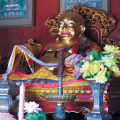Literally «Palaces of the Eternal Harmony». It's a visit to not miss under any pretext! Located north-east of the Forbidden City, it is one of the largest, one of the most beautiful and best preserved among the temples of Beijing.
History
Formerly designed to be the palace of one of the emperor Kangxi's sons (1661-1722), Emperor Yongzheng, the building was rebuilt under the emperor Qianlong (son and successor of Yongzheng), who transformed him into a temple Tibetan where more than three hundred lamas were established responsible for studying Chinese and tattoo students. Every day there were ceremonies strongly inspired by Tibetan rites, sometimes barbarian, so we were reproducing with a doll the ritual of human sacrifice, some books even say that «red liquids were incorporated into the paste in which the doll was shaped, in order to reproduce the blood!» '. Everything was accompanied by dances executed by masked men… All this belongs to history now and you will not have the opportunity to attend such ceremonies that are no longer practiced and have been replaced by mere recitations of collective prayers around rice offerings and coins. At the fall of the last dynasty, the temple fell into ruins, and had to wait until an order was made the "national monument" to restore it… and reopen its doors in the 1980 s. Today the temple is inhabited by a community of monks, disciples of the Dalai Lama, members of the reformed Yellow Bonnets Cult (Gelukpa).
Visit
The temple consists of a succession of five courses planted with rooms of worship to the increasing importance as progress progresses northwards.
The first hall, the door of the Harmony (Yonghemen), is traditionally dedicated to Maitreya, the Buddha of the Future, which welcomes the faithful at the entrance of the temple. On both sides of Maitreya are the two pagoda of Longevity, incrusted with long-lived Buddhist symbols. Two pairs of guards protect the God of evil spirits, because according to Buddhism the Earth would be divided into four worlds protected by armed guards. Behind the screen, facing the north, is a statue of Wei Tuo, the protector of Buddhism.
Then we enter the second courtyard, the buildings that framed it are devoted to studying medicine, mathematics, eyelcerism and Buddhist philosophy. You will notice a beautiful collection of tankas (roller-colored paintings) and, at the bottom of the courtyard in the hall of the Eternal Harmony (Yonghe Dian), the three Buddhas of the present, the Past and the Future.
At the bottom of the third courtyard, the Hall of the Eternal Protection (Yongyou Dian), formerly the bedroom of Emperor Yongzheng while still only a prince, now houses three Buddha wooden Buddhas; the Longevity Buddha in the center, framed on the left by the Buddha of Medicine, and on the right by the Buddha to the roaring lion (the one who scares bad spirits).
Then we enter the fourth court. Do not forget to pause for a few moments to admire some examples of lamaic art in the side galleries, and you will discover in front of you the Salle de la Loi (Falun Dian), or take religious services on a daily basis. The architecture was developed according to the plan of a Greek cross and, by lifting your eyes, you will notice the complexity of the ceiling, unrelated to the previous flags. In the center of the hall, a huge golden statue of Tsong Kapa, the founder of the reformed Gelukpa doctrine, which instituted the abolition of marriage and hereditary mandate for its members. On the side walls of the temple, great frescoes reveal the story of Tsong Kapa, and on the wall of the Five Hundred Arhats, disciples allegedly slept in writing the sutras made by Sakyamuni.
The fifth and last courtyard reveals the Ten Thousand Bonheurs flag (Wan Fu Ge), a three-story pavilion, connected to two side pavilions by two hanging galleries. It is also called the tower of the Great Buddha, as it contains a giant statue of Maitreya. This 26 m high statue (18 m above ground and 8 m below), carved in a single trunk of santal wood from Tibet, is a gift made to Emperor Qianlong by the seventh Dalai Lama.
Did you know? This review was written by our professional authors.
Book the Best Activities with Get Your Guide
Members' reviews on LAMA TEMPLE
The ratings and reviews below reflect the subjective opinions of members and not the opinion of The Little Witty.
Find unique Stay Offers with our Partners





Trotz der vielen Menschen eine wunderbare Stimmung, kein Gedränge, entspannte Gelassenheit.
Eintrittskarten bekommt man direkt im Eingang. Ein bisschen Wartezeit ist wie überall in Peking immer.